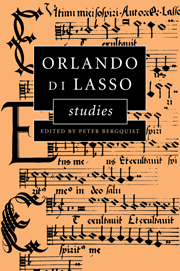Book contents
- Frontmatter
- Contents
- Preface
- List of abbreviations
- 1 Aspects of form in Orlando di Lasso's Magnificat settings
- 2 Orlando di Lasso and Andrea Gabrieli: two motets and their masses in a Munich choir book from 1564–65
- 3 Post-Tridentine liturgical change and functional music: Lasso's cycle of polyphonic Latin hymns
- 4 The salon as marketplace in the 1550s: patrons and collectors of Lasso's secular music
- 5 Lasso's “Standomi un giorno” and the canzone in the mid-sixteenth century
- 6 Lasso's “Fertur in conviviis”: on the history of its text and transmission
- 7 Orlando di Lasso and Rome: personal contacts and musical influences
- 8 Orlando di Lasso as a model for composition as seen in the three-voice motets of Jean de Castro
- 9 The madrigal book of Jean Turnhout (1589) and its relationship to Lasso
- 10 Modal ordering within Orlando di Lasso's publications
- 11 Correct and incorrect accentuation in Lasso's music: on the implied dependence on the text in classical vocal polyphony
- General index
- Index of Lasso compositions and printed sources
Preface
Published online by Cambridge University Press: 18 December 2009
- Frontmatter
- Contents
- Preface
- List of abbreviations
- 1 Aspects of form in Orlando di Lasso's Magnificat settings
- 2 Orlando di Lasso and Andrea Gabrieli: two motets and their masses in a Munich choir book from 1564–65
- 3 Post-Tridentine liturgical change and functional music: Lasso's cycle of polyphonic Latin hymns
- 4 The salon as marketplace in the 1550s: patrons and collectors of Lasso's secular music
- 5 Lasso's “Standomi un giorno” and the canzone in the mid-sixteenth century
- 6 Lasso's “Fertur in conviviis”: on the history of its text and transmission
- 7 Orlando di Lasso and Rome: personal contacts and musical influences
- 8 Orlando di Lasso as a model for composition as seen in the three-voice motets of Jean de Castro
- 9 The madrigal book of Jean Turnhout (1589) and its relationship to Lasso
- 10 Modal ordering within Orlando di Lasso's publications
- 11 Correct and incorrect accentuation in Lasso's music: on the implied dependence on the text in classical vocal polyphony
- General index
- Index of Lasso compositions and printed sources
Summary
Orlando di Lasso (1530/2– 1594) was the most famous, popular, and acclaimed composer of his day. Born in Mons in what is now Belgium, as a subject of the Empire, he spent his formative years in Italy, serving as choirmaster at St. John Lateran in Rome when he was barely twenty years old. He soon returned north, however, and settled in Antwerp for a few years until he was hired in 1556 by Duke Albrecht V of Bavaria in Munich, where he lived and worked for the rest of his life. His birth in a French-speaking area and his Italian sojourn together with his long residence in Germany (he probably also visited England briefly in the mid–1550s) made him the most cosmopolitan musician of his day. Early on he was recognized as a leading composer throughout Europe, and publications of his music far exceeded those of any contemporary, or for that matter any other musician for at least a century afterwards. He was especially noted for his ability to convey in music the content of the text he was setting; an early commentator praised his ability to “place the object almost alive before the eyes.” Only during the last ten years or so of his life did his popularity wane, though he composed prolifically almost without interruption through his last years, and his music remained a model and a pervasive influence in Germany well into the seventeenth century.
- Type
- Chapter
- Information
- Orlando di Lasso Studies , pp. vii - xPublisher: Cambridge University PressPrint publication year: 1999

